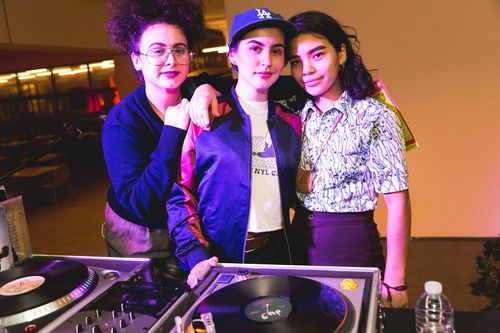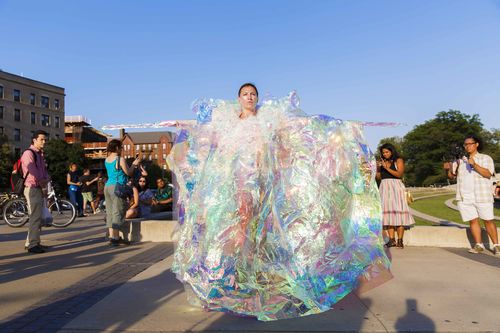
Radical Women: Latin American Art, 1960–1985
Radical Women: Latin American Art, 1960–1985 presents the work of 120 women artists and collectives active in Latin America and the United States during a key period in Latin American history and the development of contemporary art. The artists represent fifteen countries and include emblematic figures such as Lygia Clark, Ana Mendieta, and Marta Minujín as well as lesser-known contemporaries such as the Cuban-born abstract artist Zilia Sánchez, the Colombian sculptor Feliza Bursztyn, and the Brazilian video artist Letícia Parente. The exhibition is the first survey of radical and feminist art practices in Latin America and among Latina artists in the United States.
For women artists in Latin America, the decades covered by the exhibition were a time of both repression and liberation. Most countries in the region were ruled by dictatorships or riven by civil war at some point during these years. The lives of many of the artists featured in Radical Women were thus enmeshed in experiences of authoritarianism, imprisonment, exile, torture, violence, and censorship. Yet this period also saw the emergence of new sensibilities. While few Latin American women artists identified as feminists, their works and their lives often manifested a vision of the female universe at odds with the region's repressive regimes and deeply rooted patriarchal values. The Latina and Chicana artists working in the United States developed an aesthetic that addressed the marginalization of women and of their own communities in American society. Many of them participated in the civil rights, antiwar, gay rights, and feminist movements. Whether based in Latin America or the United States, the artists embraced the expanded possibilities of the era, with some contributing to the revitalization of traditional mediums such as painting and sculpture and others taking up new disciplines such as video art, performance, and conceptual practices.
Central to the diverse works in Radical Women is the notion of the political body. The themes around which the exhibition is organized—the self-portrait, the relationship between the body and landscape, the mapping of the body, the erotic, the power of words, the performative body, resistance and fear, feminisms, and social places—serve to render visible the shared concerns of artists across a vast geographic region.
Radical Women: Latin American Art, 1960–1985 presenta el trabajo de 120 mujeres artistas y colectivos, ambos activos en América Latina y los Estados Unidos durante un período clave en la historia de Latinoamérica y en el desarrollo del arte contemporáneo. Las artistas representan a quince países, y la selección incluye figuras emblemáticas como Lygia Clark, Ana Mendieta y Marta Minujín, así como artistas coetáneas menos conocidas como la artista abstracta cubana Zilia Sánchez, la escultora colombiana Feliza Bursztyn y la vídeoartista brasilera Letícia Parente. Esta exposición representa el primer panorama de las prácticas radicales y feministas desarrolladas tanto en América Latina como por las artistas latinas radicales en los Estados Unidos.
Las artistas de América Latina vivieron momentos tanto de represión como de liberación durante las décadas que abarca la muestra. Casi todos los países de la región estaban bajo dictaduras o fueron divididos por guerras civiles en algún momento durante ese período. Muchas de las artistas de Radical Women por lo tanto vivieron experiencias de autoritarismo, encarcelamiento, exilio, tortura, violencia y censura. Sin embargo, en esta etapa también surgieron nuevas sensibilidades. Si bien pocas mujeres artistas latinoamericanas se autoidentificaron como feministas, a menudo manifestaron en sus vidas y obras una visión del universo femenino contraria a la de los regímenes represivos firmemente arraigados en valores patriarcales. Las artistas latinas y chicanas que trabajaban en los Estados Unidos, desarrollaron propuestas estéticas que abordaron temas de marginalización de la mujer y de sus propias comunidades en la sociedad norteamericana. Muchas de ellas participaron en los movimientos de apoyo a los derechos civiles, contra la guerra, en pro de derechos homosexuales y feministas. Bien fuese viviendo en América Latina o en los Estados Unidos, las artistas abordaron las posibilidades más amplias del momento, y mientras algunas contribuyeron a la renovación de los medios tradicionales como la pintura y la escultura, otras se dedicaron a nuevas disciplinas como videoarte, performance y prácticas conceptuales.
El núcleo central de las obras que conforman Radical Woman es la noción del cuerpo político. Los ejes temáticos en torno a los cuales fue organizada la exposición —el autorretrato, la relación entre el cuerpo y el paisaje, el cuerpo cartografiado, lo erótico, el poder de las palabras, el cuerpo actuando, miedo y resistencia así como feminismos y el lugar social — sirven para ilustrar los intereses y las problemáticas compartidas de estas artistas a través de una vasta región geográfica.










![Edita (la del plumero), Panamá (Edita [the one with the feather duster], Panama), from the series La servidumbre (Servitude), by Sandra Eleta, 1978–89](/sites/default/files/styles/archive_artwork_thumbnail/public/migrated-assets/media/Digital_archives/Radical_Women/Art/eleta_sandra_edita.jpg?itok=IbmnZ8SP)













